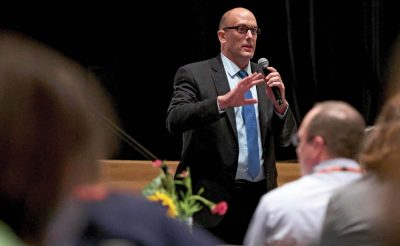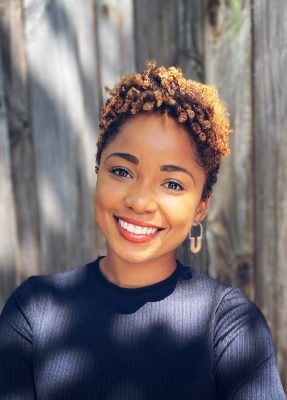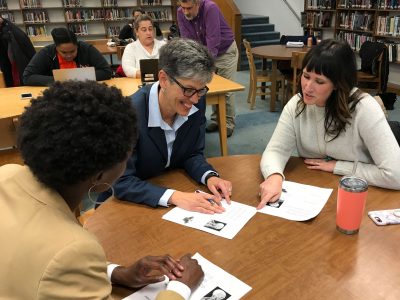SOE’s educational leadership programs promote institutional and educational equity.
Issues of access and opportunity are central to equity-focused educational leadership, which are also central to inclusive systems and philosophy. “Equity in education means full inclusion and educational excellence for every child, not just welcoming every child but ensuring opportunity to learn based on what each student needs,” says George Theoharis, professor of educational leadership and inclusive education.

Theoharis and his educational leadership colleagues—Leela George, associate teaching professor, and Courtney Mauldin, assistant professor—use popular illustrations that depict equity and equality as well as the historical and modern barriers that students face, portraying students watching a baseball game behind an uneven fence. Some students stand on lower ground, which changes the height of the uneven fence, or systemic barrier, in front of them and blocks their access even further. Another image shows them working together to tear the fence down: justice. This is the unlevel playing field that equity in education seeks to remedy. In class, educational leadership students critique and remix their own images into the illustrations to show how they comprehend concepts of equality, equity and justice. “These images, and our programs, intentionally see the challenges of struggles as located not within the child but as the result of systems of inequality and inequity, the same viewpoint that guides us in teaching and leadership,” says George. “The images depict this by showing the three students as the same height, yet different because of their movements and colors.”
All too often, educational discourse embraces what the professors call deficit thinking, which positions the challenges and problems within the child, family or community. In the SOE programs—the certificate of advanced study (C.A.S.) and the doctorate (Ed.D.) in educational leadership—faculty ask students to wrestle with the ways they personally have embraced deficit thinking and where they see it in their schools.

“Inclusion means providing each student what they need in the same space and ending practices of selecting and sorting children based on ability, which further exacerbates the achievement or opportunity gap,” says Mauldin. She adds that educational equity “should impact all areas of schooling, from culture, staffing, outreach and family engagement to instruction, curriculum and scheduling. It is about understanding how all the identities students and adults bring to school impact them and the school,” Mauldin says.
Equity-focused leadership taught in the School of Education makes issues of race, class, sex, gender identity, disability, sexual identity and other historic and current marginalizing conditions in the United States central to educators’ advocacy, practice and vision. This concept centers on addressing and eliminating marginalization in schools, and inclusion is a necessary condition for this equity.
Theoharis says that the challenges to creating more equitable schools are numerous. “Systemic inequity spans across historical, institutional, individual and interpersonal levels—interwoven with issues of race, poverty and disability.”
“When we say historical, we mean that the problems we face today have their roots in centuries of human experience,” adds Theoharis.
He offers this example: Many families with homes in suburban communities in the Northeast and Midwest parts of the U.S., like the suburbs around Syracuse, can trace pieces of their economic status back to the GI Bill, when their grandfathers received federal assistance to attend college, participate in job training, start a new business and buy a home after their military service in World War II. These benefits were disproportionately available to white male veterans over African American and female veterans. Given that higher wages and home ownership are two fundamental ways to build family wealth, 70 years and three generations later the housing patterns, class differences and residential segregation reflect that history.
“People carry their histories,” Theoharis says. “Your histories inform what you think, how you feel and how you react.”
People who have been taught that they’re entitled to a good education expect one and will be more likely to demand improvement should they suspect their school is falling short, George says. Conversely, people whose lived experience in schools includes a pattern of unfair, disrespectful and exclusionary treatment will look for signs that patterns are repeating.
Inequity is also institutional, or structural, meaning “the way our system of schooling, and our entire society, are built and organized predictably lead to the types of disparate outcomes that exist today,” says Mauldin. The laws, processes and organizations used to engage in schooling and other aspects of today’s society perpetuate historical and current patterns of inequity and injustice.
“It is also essential that we recognize the importance of context when doing equity work. This means that we must be able to see the fence in the equity illustration—to really see it and evaluate historical systems and structures that have perpetuated inequity in our schools. Our work then, is to begin to dismantle those structures with a targeted reach.”
Adds Theoharis, “So many decades of tax, finance, housing and banking policies and practices have been built on top of the GI Bill that it is easy to avoid noticing how these institutionalized policies and practices extend existing inequities.”
Housing inequity, he says, also contributes to school inequity: Because housing in the United States is racially and economically segregated, and children tend to go to schools near where they live, children end up going to school with other children of their same race and income level. For many people, the most common way of defining inequity is individual or interpersonal; many want to believe that racism is about overt, intentional acts of malice, such as white supremacist organizations and people who commit hate crimes.
“It is easy to think that only bad people who carry bad attitudes are the ones who perpetuate racism, sexism, class discrimination and other forms of inequity,” Mauldin says. “This view of inequity allows you to think that you are not a part of it, and though you might take a role in fixing it, you can continue to think that you are not contributing to it.”
Still, research has found that everyone carries their histories and biases, which contribute to negative judgment, exclusion and discrimination.

“We realize that part of the barrier to greater equity in schools is our individual ideas and beliefs about school and children—even those held by good, well-intentioned educators and leaders—and how those play out interpersonally,” George says.
George believes school leaders have a vital role in creating more equitable and just systems—like inclusive service delivery, increased opportunity for arts and advanced academics, organization of staff, supervision of hands-on science curriculum and an expanded curricular understanding of history—as well as a key role in providing professional development opportunities in addressing interpersonal and individual barriers.
The focus of the field of educational leadership has shifted over time, says Mauldin. Fifty years ago, it emphasized school management and being a disciplinarian. In the ’80s and ’90s, researchers and practitioners grew to understand that school administrators needed to be instructional leaders, a big shift that is still ongoing. The next retooling of the educational leadership field has been to wrestle with, and ultimately move toward, equity-focused leadership.
“We believe that while school management and instructional leadership are pivotal, they alone are insufficient to create schools that are both excellent and equitable,” says Theoharis. “Our SOE programs extend these traditional aspects while grounding our work in theory and practice of equity and justice.”
